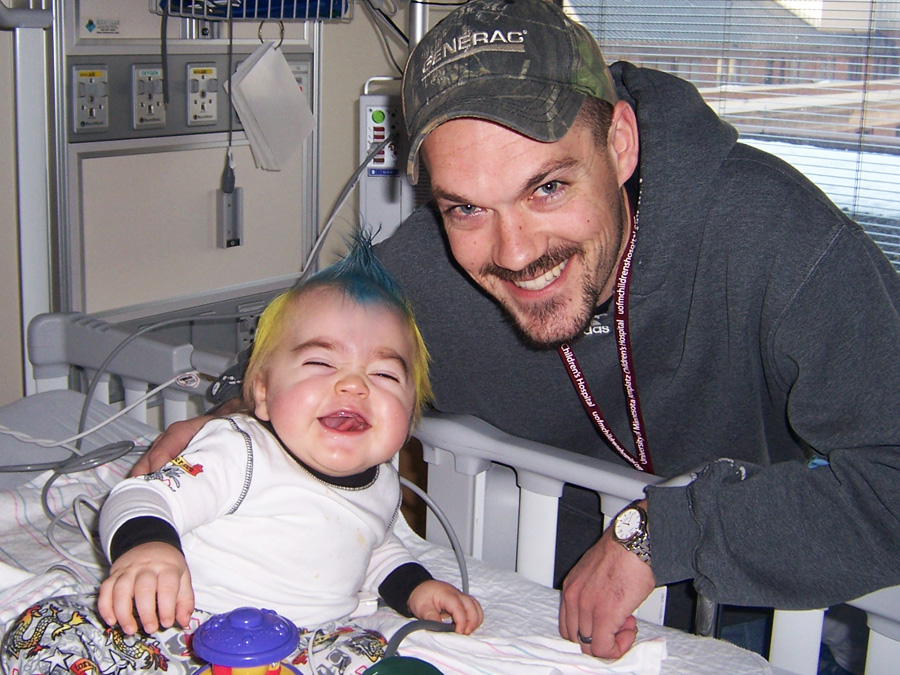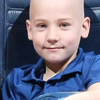Derek’s Story: Surviving Hurler Syndrome
When Derek Hanewacker of Flint, Mich., was only 10 months old he was diagnosed with Hurler Syndrome, a rare genetic disorder that causes progressive physical and mental deterioration. If left untreated, patients with Hurler syndrome typically don’t live past the age of 10. Derek’s parents Holly and Scott soon learned that the best place to treat Derek’s disease was University of Minnesota Amplatz Children’s Hospital, using stem cell therapy treatments funded in part by grants from Children’s Cancer Research Fund.
The Hanewacker family arrived in Minnesota in January to begin Derek’s workup for his umbilical cord blood transplant. While Holly was able to stay in Minnesota with Derek as he prepared for transplant, Scott had to return home to continue working, as he became his family’s sole financial provider. The family soon realized that visits from Scott would be rare, because of high airfare costs and poor winter driving conditions.

For families, stem cell transplant day is one filled with celebration and hope – hope of a new beginning and chance at life without the devastating effects of cancer or rare illness. Sadly, Scott was going to miss this important milestone, making the choice to put money toward medical bills, instead of a costly flight to Minnesota. That was until a Child Family Life specialist at the hospital surprised Hanewackers with a Care Flight.
Scott flew in on transplant day, arriving early in the morning before Derek was awake. When he woke up and saw his dad – he clapped his hands and smiled. Thanks to the generosity of SkyMiles donors, Scott was there for Derek’s big day, standing by his wife Holly’s side, thankful to be together for this important milestone.

Alijah’s Story: Surviving Acute Lymphocytic Leukemia (ALL)
Watching your child grow and move forward through developmental milestones—learning to sit, to crawl, to take the first tottering step—is a joyful process for any parent. How frightening, then, to watch your child suddenly seem to “grow backwards.” That is what Kyle and Jamekka experienced when their two-year-old son Alijah stopped walking.
“He just started crawling again,” recalls Jamekka. “He would go for four or five days crawling with his foot up in the air like it was hurting. Then he’d walk for a few days then go back to crawling. Sometimes his right ankle hurt, sometimes his left, sometimes it was his wrist. We thought something might have happened at daycare…” But that turned out not to be so.
Soon, Alijah started running a high fever at night and Jamekka took her son to the family’s regular pediatrician. After repeated visits, with tests and x-rays coming back negative, the pediatrician referred Alijah to a rheumatologist, suspecting his mysterious pains might be a sign of rheumatoid arthritis. Once again scans and tests showed no problems. Alijah definitely did not have RA.
However, the rheumatologist thought Alijah should be seen by a hematologist. She was concerned that a blood disorder might be causing his symptoms. She referred the family to University of Minnesota Amplatz Children’s Hospita
The next day, doctors diagnosed Alijah with acute lymphocytic leukemia (ALL) after performing a bone marrow biopsy and finding leukemia cells in his marrow.
Luke’s Story: Surviving Osteosarcoma
When you are 16, 14 and 11 years old, the last thing you want to hear is that you can’t have friends over. Luke’s brothers and sister are used to that now, however, because when Luke’s blood count is down, the family closes around him.
“We have always had an open house,” said Luke’s mom, Jamie. “His osteosarcoma has changed the dynamics of our home and our family. Little things just don’t matter all that much now.”
It began with a wrestling match. Luke broke his left femur wrestling with his brother, and x-rays revealed a tumor at the site of the break. “It’s creepy to think the tumor had been there long enough to weaken the bone,” said Jamie. “Luke had told us on occasion that his leg hurt, but we thought it was just growing pains.”
Luke was diagnosed with osteosarcoma in December 2009. Osteosarcoma is the most common type of bone cancer, often found in teens and young adults. Terrified and sad, Luke’s parents turned to the Internet for information but soon found that to be “way too scary,” said Jamie. Referred by their orthopedic physician to the University of Minnesota, Luke and his family began their healing journey under the guidance of Joseph Neglia, M.D., section chief of Pediatric Hematology and Oncology and a professor in the Department of Pediatrics Division of Pediatric Hematology/Oncology/Blood and Marrow

Adalyn’s Story: Surviving Retinoblastoma
Adalyn of South Saint Paul, Minnesota was diagnosed with Retinoblastoma on September 24, 2012, at mere 9 months old. “Never did we imagine that we would be told that she had a tumor in her retina and that it was cancer” parents Tim and Theresa recall.
Retinoblastoma typically shows up as a “white glow” in the eye, something that Tim and Theresa remember noticing in their pictures of Adalyn since she was 5-6 months old, but never knew it was a problem.
After consulting with their doctors Tim and Theresa were told to take Adalyn to the University of Minnesota’s Amplatz Children’s Hospital, which besides Mayo was the only hospital in Minnesota that treated Retinoblastoma.
Adalyn received six rounds of chemo broken down into a six month treatment plan, staying two-three days each time.
Armed with her taggie blanket, soothie nuks, music and baby dolls, Adalyn has demonstrated enormous bravery in the face of chemo treatments and constant hospital visits. Although she hasn’t known life without doctors and hospitals it has never seemed to affect her. She smiles and laughs just as much now as during hospital visits and together with her family is just living life the best they can and taking it one day at a time.
Since completing her cancer treatment, Adalyn is now back at daycare and her family is slowly starting to understand their “new normal” and getting back into a routine. “Cancer is like a home invasion, once it has invaded your life you will never feel safe again” says Tim and Theresa.

Caden’s Story: Surviving a Brain Tumor
At six-and-a-half years old, Caden of Fall Creek, Wisconsin is learning something that separates him from the rest of his classmates at his school—he is learning Braille.
“My teacher calls me a Superhero at Braille, because I get 100% on every spelling test” Caden says proudly.
Shortly before his second birthday, Caden’s parents Tracy and Thane noticed a deviation in Caden’s right eye. They brought him in to see an ophthalmologist, but the standard method of treatment just seemed to make the deviation worse. Caden was quickly pushed up the list to receive an MRI at the University of Minnesota. What the MRI revealed came as a shock to everyone.
The MRI revealed a brain tumor located behind Caden’s eyes, along his optic nerves, known as a bilateral optic glioma. Due to the location of the tumor, removing it surgically was not an option, and following his second birthday Caden started chemotherapy treatment.
Throughout the course of his treatment, different forms of chemotherapy and medications have been tried to reduce the tumor growth. However, Caden’s brain tumor has proven to be a special case.
In his spare time, Caden participates in activities that a child receiving chemotherapy treatment typically does not. Caden has been playing piano for several years and just started taking guitar lessons. With both instruments he is learning to play using the Suzuki method, where Caden learns each song aurally through imitation.
One of his favorite songs to play on the piano is called “Goodbye to Winter” which he playfully refers to as, “Hi
To Winter” since he loves jumping around in the snow
I M SO HAPPY THAT EVERYONE ONE CAME THROUGH THEIR SUFFED THEY WANT THROUGH. ITS SAD WHEN YOUNG PEOPLE HAVE TO SUFFED THROUGH THE PAIN THEY HAVE AT A YOUNG AGE. GOD WAS WITH THEM THOUGH THIER PAIN AND SUFFER
No comments:
Post a Comment